Rare system of five stars discovered BBC - July 8, 2015
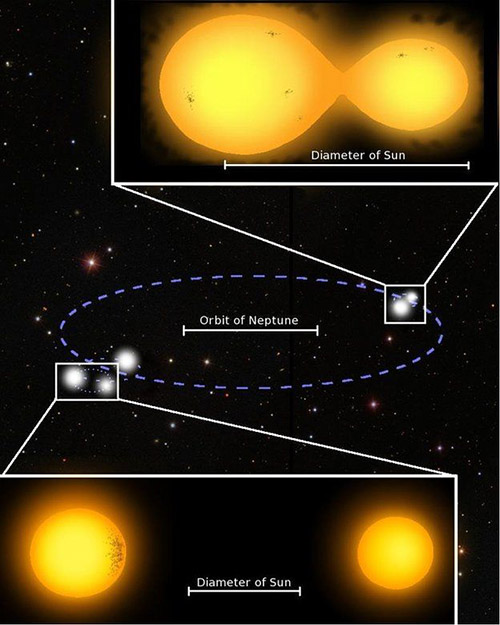
The quintuplet consists of a pair of closely linked stars - binaries - one of which has a lone companion; it is the first known system of its kind. The pair of stars orbit around a mutual centre of gravity, but are separated by more than the distance of Pluto's orbit around the Sun.
 Black hole awakens, erupts after 26 years CNN - July 7, 2015
Black hole awakens, erupts after 26 years CNN - July 7, 2015
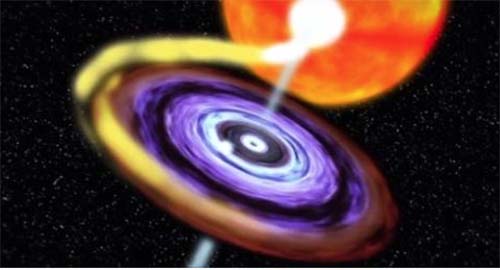
Astronomers use cosmic gravity to create a 'black-hole-scope' PhysOrg - July 7, 2015
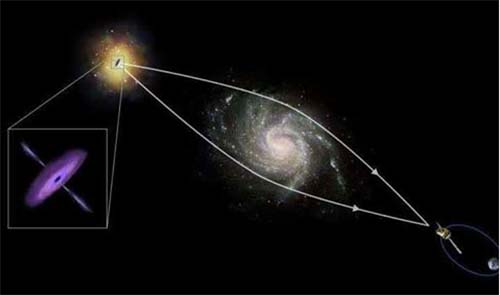
The Integral, Fermi and Swift space observatories have used the magnifying power of a cosmic lens to explore the inner regions of a supermassive black hole. Massive cosmic objects, from single stars to galaxy clusters, bend and focus the light that flows around them with their gravity, acting like giant magnifying glasses. Dr Neronov and colleagues used a star sitting between their target and Earth to 'zoom in' to the black hole and measure the size of the jet-emitting region - the first time this method has ever been used with gamma rays.
Astronomers see pebbles poised to make planets Astronomy.com - July 7, 2015

A team of astronomers led from St. Andrews and Manchester universities has announced the discovery of a ring of rocks circling a young star. This is the first time these 'pebbles', thought to be a crucial link in building planets, have been detected. Planets are thought to form from the dust and gas that encircles young stars in a disk. Over time, dust particles stick together until they build up bigger clumps. Eventually, these have enough mass that gravity becomes significant, and over millions of years the clumps crash together to make planets and moons. In our own solar system, this process took place about 4.5 billion years ago, with the giant planet Jupiter the first to form.
New Horizons: Pluto map shows 'whale' of a feature BBC - July 8, 2015
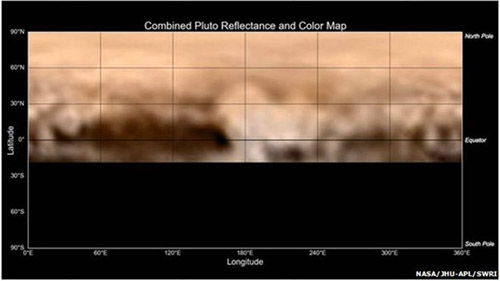
Scientists have released their latest map of Pluto, using images from the inbound New Horizons spacecraft. It unwraps the visible parts of the sphere on to a flat projection, giving another view of the features that have started to emerge in recent days. Evident are the light and dark patches at the equator, including one long dark band being dubbed "the whale". The US space agency's (Nasa) New Horizons probe is now less than seven days away from its historic flyby.
 Reaching Pluto, and the End of an Era of Planetary Exploration New York Times - July 7, 2015
Reaching Pluto, and the End of an Era of Planetary Exploration New York Times - July 7, 2015
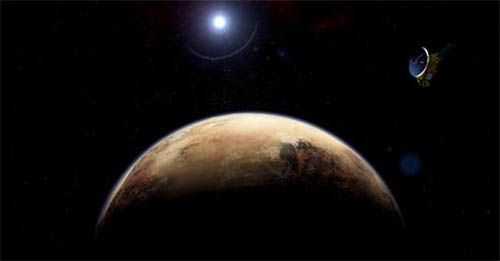
On July 14, we are to clear the last of the big hills. After a journey of nine and a half years and three billion miles, the New Horizons spacecraft is to go past Pluto, once the ninth and outermost planet, the last of the known worlds to be explored. This is the beginning of the end of a phase of human exploration. The crawling-out-of-our-cradle-and-looking-around part is over.
What is the newest planet? PhysOrg - July 7, 2015
With astronomers discovering new planets and other celestial objects all the time, you may be wondering what the newest planet to be discovered is. Well, that depends on your frame of reference. If we are talking about our Solar System, then the answer used to be Pluto, which was discovered by the American astronomer Clyde William Tombaugh in 1930. Unfortunately, Pluto lost its status as a planet in 2006 when it was reclassified as a dwarf planet.
 Mount Spock? New Horizons' Pluto Name List Will Please 'Star Trek' Fans NBC - July 7, 2015
Mount Spock? New Horizons' Pluto Name List Will Please 'Star Trek' Fans NBC - July 7, 2015
The team behind NASA's New Horizons mission has drawn up its proposed list of names for yet-to-be-discovered geological features on Pluto and its moons - and the lineup ranges from Gilgamesh (the mythical hero of the Mesopotamian epic of the 22nd century B.C.) to Mr. Spock (the fictional Vulcan from the 23rd century A.D.).
Earth and Mars could share a life history PhysOrg - July 7, 2015
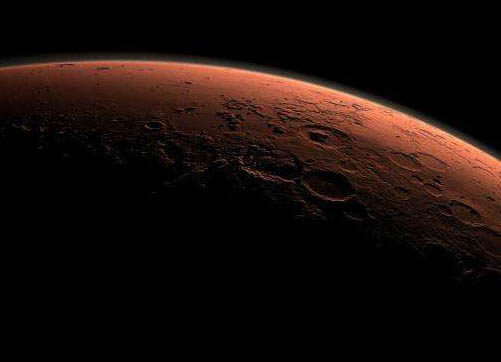
While life is everywhere on Earth, there is much debate about how it began. Some believe it originated naturally from the chemistry found on our planet as it evolved. Others hypothesize that life - or at least the building blocks of it like DNA - crashed onto our planet from such extraterrestrial bodies as comets.
Martian gems could point to evidence of life PhysOrg - July 7, 2015
Scientists have discovered for the first time direct physical evidence of the existence of opals on Mars. The traces of the precious stone, which were found in a Martian meteorite, could help future exploration missions decide where to look for evidence of life on the red planet.
Catching Earth at aphelion PhysOrg - July 7, 2015

Do you feel a little ... distant today? The day after the 4th of July weekend brings with it the promise of barbecue leftovers and discount fireworks. It also sees our fair planet at aphelion, or its farthest point from the sun. In 2015, aphelion (or apoapsis) occurs at 19:40 Universal Time (UT)/3:40 PM EDT today, as we sit 1.01668 astronomical units (AU) from the sun. This translates to 152.1 million kilometres, or 94.5 million miles. We're actually 3.3% closer to the sun in early January than we are today. This also the latest aphelion has occurred on the calendar year since 2007, and it won't fall on July 6th again until 2018. The insertion of an extra day every leap year causes the date for Earth aphelion to slowly vary between July 3rd and July 6th in the current epoch.
NASA's Dawn holding in second mapping orbit PhysOrg - July 7, 2015
On June 30, shortly after turning on its ion engine to begin the gradual spiral down to the next mapping orbit, its protective software detected the anomaly. Dawn responded as designed by stopping all activities (including thrusting), reconfiguring its systems to safe mode and transmitting a radio signal to request further instructions. On July 1 and 2, engineers made configuration changes needed to return the spacecraft to its normal operating mode. The spacecraft is out of safe mode, using the main antenna to communicate with Earth.
Transition discs in Ophiuchus and Taurus PhysOrg - July 7, 2015
A star is typically born with a disk of gas and dust encircling it, from which planets develop as dust grains in the disk collide, stick together and grow. These disks, warmed by the star to a range of temperatures above the cold, ambient interstellar material, can be detected at infrared or millimeter wavelengths, and their infrared color used to characterize their properties.
Starry Vortex Takes Top Spot in Nightscapes Photo Contest Live Science - July 7, 2015

A vortex of stars seems to swirl above Table Mountain in South Africa in the winning image of this year's International Earth & Sky Photo Contest. The contest highlights stunning "nightscapes," or images that combine the night sky with Earthly scenery. Winner Eric Nathan, a self-taught freelance photographer, stacked more than 900 30-second exposures to create the image, which shows star trails caused by the rotation of the Earth.
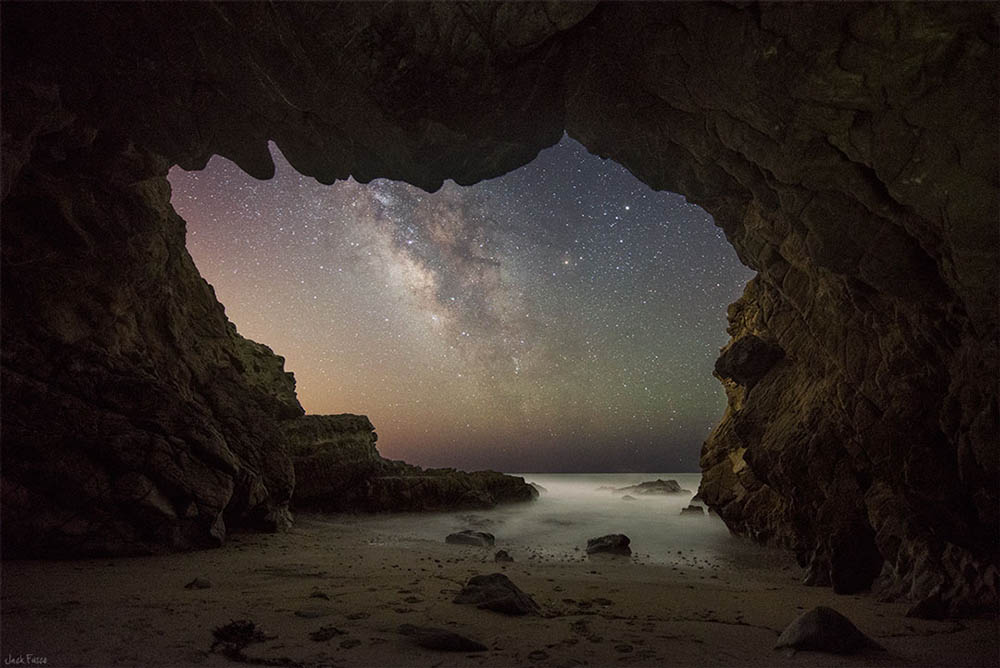
The Milky Way from a Malibu Sea Cave
APOD - July 7, 2015
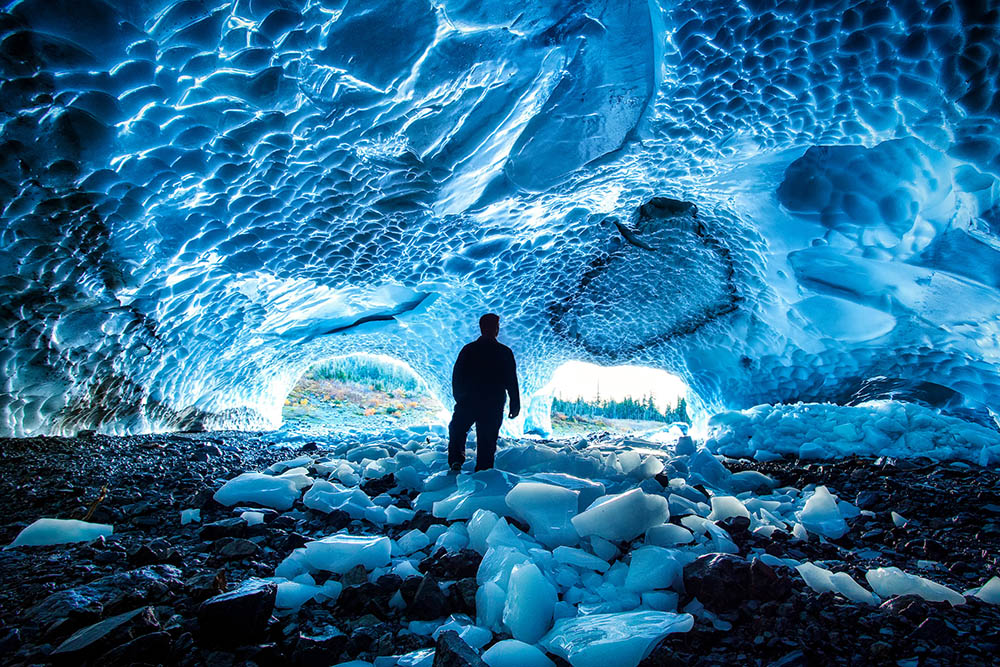
Big 4 Ice Caves in Washington State
With climate change, ice caves are melting down.
Caves symbolize the mind which for many is also melt-down time.
 Woman, 34, Killed in Washington Ice Cave Collapse NBC - July 7, 2015
Woman, 34, Killed in Washington Ice Cave Collapse NBC - July 7, 2015